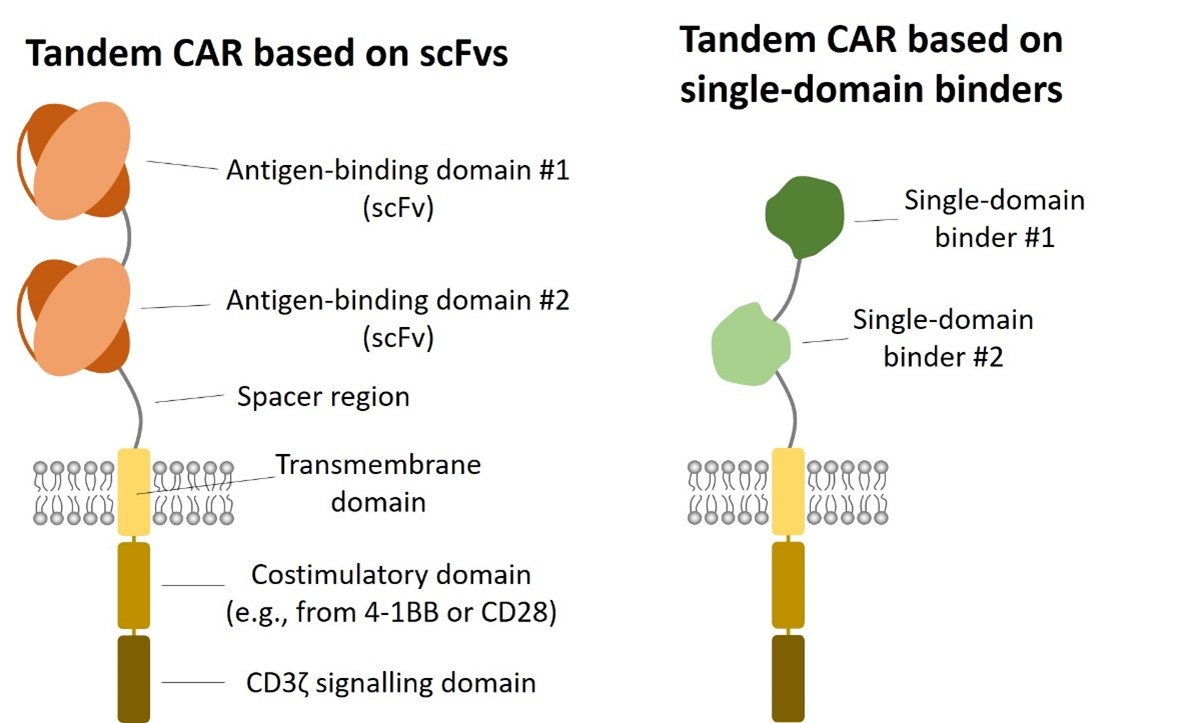Engineering OR-gated CAR T cells to prevent resistance due to antigen loss
PRINCIPAL INVESTIGATOR: Michael TRAXLMAYR
Background.
T cells genetically engineered to express chimeric antigen receptors (CAR T cells) have shown impressive clinical response rates in the treatment of hematologic malignancies such as B cell acute lymphoblastic leukemia (B-ALL) and diffuse large B cells lymphoma (DLBCL) (Majzner and Mackall, 2019). Most currently approved CAR T cell products are directed against the B cell marker CD19 to eliminate B cell-derived malignancies. However, despite high initial complete response rates, a considerable fraction of the patients relapses with antigen-negative disease (Majzner and Mackall, 2019). That is, these cancer cells lose expression of the target protein CD19 and thereby escape from the CD19-directed CAR T cell therapy. To prevent such antigen loss, OR-gated CAR T cells have been generated, which express so-called tandem CARs containing two antigen binding domains directed against antigen A and B, respectively. As a consequence, these CAR T cells eliminate target cells that express antigen A, or antigen B or antigens A+B, hence the name OR-gated CAR T cells. This strategy strongly reduces the risk of escape due to antigen loss, because a single cancer cell would have to simultaneously down-regulate expression of two antigens, which is highly unlikely.
One major problem with OR-gated CAR T cells is the requirement to express two antigen-targeting domains within one CAR molecule. Antigen recognition by CARs is usually mediated by single-chain variable fragments (scFvs). However, scFvs tend to show mispairing with neighboring molecules, resulting in the formation of so-called diabodies (Arndt et al., 1998; Zajc et al., 2021). In the case of OR-gated CARs, where two scFvs need to be expressed in tandem, the risk of mispairing is even further increased. Thus, alternative approaches for the generation of OR-gated (bispecific) CAR molecules are highly desired.
Aims and methods.
It is the goal of this project to engineer OR-gated CAR T cells based on non-scFv-based binding domains. We have recently developed a binding scaffold platform that is based on single protein domains (Teufl et al., paper in preparation), which therefore eliminates the risk of domain-mispairing.

First, we will engineer single-domain binders against two tumor antigens found on the same tumor entity. Next, the generated binders will be analyzed with respect to their affinity (titration on antigen-expressing mammalian cell lines), their thermal stability (differential scanning calorimetry, DSC) and their aggregation tendency (size exclusion chromatography, SEC). After this detailed biochemical characterization, the most promising binders directed against antigens A and B will be combined into one CAR molecule and tested for their ability to activate CAR T cell function in response to antigen A- and/or antigen B-expressing target cell lines.
Collaborations within this thesis will include Manfred LEHNER, CCRI, Vienna (CAR T cells).
Arndt, K.M., Muller, K.M., and Pluckthun, A. (1998). Factors influencing the dimer to monomer transition of an antibody single-chain Fv fragment. Biochemistry 37, 12918-12926.
Majzner, R.G., and Mackall, C.L. (2019). Clinical lessons learned from the first leg of the CAR T cell journey. Nat Med 25, 1341-1355.
Zajc, C.U., Salzer, B., Taft, J.M., Reddy, S.T., Lehner, M., and Traxlmayr, M.W. (2021). Driving CARs with alternative navigation tools - the potential of engineered binding scaffolds. FEBS J 288, 2103-2118.
